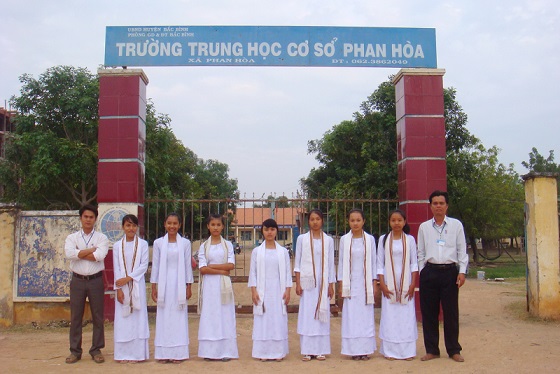Van Ngoc Sang, Jueli Nguyen. Student Perception of Using Project-Based Learning (PjBL): A Case Study in Universiti Teknologi Malaysia (UTM). The 7th International Conference on University Learning and Teaching (InCULT 2014). Proceedings: Educate to Innovate. ISBN: 978-981-287-663-8 (Print). ISBN: 978-981-287-664-5 (Online). Pp. 387-397, November 24, 2015. [DOI 10.1007/978-981-287-664-5_31]. Published by Springer. Singapore.
7th International Conference on University Learning and Teaching (InCULT 2014) Proceedings
Letter: 7th International Conference on University Learning and Teaching
Abstract: Active learning has attracted strong advocates among faculty looking for alternatives to traditional teaching methods. Project-based learning has been recently introduced as an add-on teaching method in some countries. In Universiti Teknologi Malaysia, Project-Based learning has been introduced as part of the curriculum to inculcate entrepreneurial thinking skills. This paper discusses the feedback on students’ perceptions regarding the implementation of project-based learning. The findings of the paper show that most students have positive perception of using Project-based learning as a teaching method and agree to learn using the same method in the future. Learners also highly appreciated that project-based learning promoted their soft-skills, includes of Teamwork; Project Management; Communication Skills, Interpersonal Skills. The results of the study did not show any significant differences in perceptions between male and female students in using Project-based learning in the training programs.
Keywords: project based learning, soft skills, student perception
1. Introduction
Higher Education Institutions (HEIs) in developing countries aimed to put the words of Innovative - Global - Entrepreneurial in their mission as the directions for activities and strategic thrusts in order to move forward towards being a global university. HEIs try to provide stimulating, entrepreneurial and quality learning environment for students in discipline to achieve their study goals. One of the initiatives for achieving this thrust is the implementation of project-based learning (PjBL) in curriculum with the aim of exposing students to the real world and inculcating entrepreneurial thinking skills as well as developing soft-skills to enable them to adapt to the highly competitive labor market environment.
Using PjBL as a teaching method has been proven to be effective which engages students in an organized and cooperative manner to investigate and resolve certain problems. Moursund (2007) defines project-based learning as an individual or group activity that goes on over a period of time, resulting in a product, presentation or performance; PjBL typically has a time line and milestones, and other aspects of formative evaluation as the project proceeds. Moss, Van Duzer and Carol (1998) affirm that project-based work lends itself well to evaluations of both language skills and employability skills. Consequently, in PjBL, learners learn meaningfully through the process of exploring, scaffolding, interpreting, negotiating, and creating products namely presentation and written report required in their project work. It is undeniable that PjBL is beneficial to students’ as they acquire and practice not only workplace skills but also soft skills while carrying out the project work. Advantages of PjBL include greater student and faculty interest and interactivity, vicarious learning, and increased reflection (Bell, 2010). Furthermore, Kloppenborg, & Baucus, (2004) outlines the benefits of using PjBL as an interactive learning strategy, shifting the emphasis to more student-centred activities rather than teacher-centred.
The purpose of this study is to evaluate overall students’ perception of using PjBL in teaching and learning. In this research study the following hypotheses is are tested:
- : Students’ perceptions of using PjBL in the curriculum is related to knowing more about the real world, enjoy, learning more soft skills and gaining benefits from it.
- : Students’ perceptions of using PjBL help them develop soft skills, such as: Teamwork, Project Management, Communication Skills and Interpersonal Skills.
- : There is no significant difference between different types of gender in terms of using PjBL in the curriculum.
2. Literature Review
2.1 The benefits of project-based learning (PjBL)
Markham (2011) has described that project-based learning (PjBL) PjBL integrates knowing and doing. Students learn knowledge and elements of the core curriculum, but also apply what they know to solve authentic problems and produce results that matter. PjBL students take advantage of digital tools to produce high quality, collaborative products. PjBL refocuses education on the student, not the curriculum--a shift mandated by the global world, which rewards intangible assets such as drive, passion, creativity, empathy, and resiliency. These cannot be taught out of a textbook, but must be activated through experience.
In real workplace settings, students implement project-based learning as they are really able to gain knowledge and skills more than in classroom. For example, skills such as decision-making, problem-solving, managing conflicts, team working and being innovative are important elements of job competence. Gultekin in Bell (2010) affirms that through PjBL students become better researchers, problem solvers, and higher-order thinkers. Research supports that students using PjBL perform better on both standardized assessments and project tests than students in traditional direct instruction programs, and that they learn not only real-world application of skills, but also analytical thinking as stated in Boaler’s study (1999).
Especially, the 21st century workforce should have a new mindset in encountering the challenges and demands of the workplace. Pink (2005) argues that the workplace is changing as a result of three factors: Asia, abundance, automation and that to remain competitive workers will need new skills; Pink's findings correspond with those of other experts and researchers who have studied the changing workplace and the skills that will be needed for continued work success. In the process of PjBL student need both of academic and social skills for completing the project. Particularly, learners are involved in preparing meeting, questions and discuss to collect relevant information for their project. Rosen (1998) emphasizes that learners develop questions as a group, divide the work among individuals or pairs to find answers to selected questions using a variety of sources such as the internet or guest speakers. Rosen (1998) also states that the criteria for project work are, learners work in a group to select topics of interest and decide the direction of their learning. They rely on insights from their peers while providing feedback to others, use the teacher as a resource, but by and large, and create their own knowledge. Kloppenborg and Baucus (2004) also reported on the learning outcome of students as manifested in their successful experiences gained in planning, managing, and accomplishing projects. Kloppenborg and Baucus (2004) reiterated that many of skills learned through PjBL are highly sought by today's employers including the ability to work well with others and handle interpersonal conflicts, make thoughtful decisions, practice and solve complex problems.
Successful experiences include the ability to resolve conflicts through creative problem solving approaches and the accomplishment of a project that make them more aware of real life problems and issue. Bell (2010) states that project based learning (PjBL) promotes social learning as students practice and become proficient with the 21st century skills of communication, negotiation, and collaboration. When students share their work or challenges, a brainstorming session often helps them build on each other’s ideas for future possibilities which promotes creativity and out-of the-box thinking. Therefore, PjBL plays a significant role in exposing students to a meaningful learning process while they are engaged in completing their project.
Graduates of today need to become proficient in 21st century workplace skills as to meet the challenges of this era. The respective skills are critical thinking and problem solving, communication, collaboration, creativity and innovation; that also increasingly demand creativity, perseverance and problem solving combined with performing well as part of a team. The enGauge Report (2003) asserts that "rapid change and increased competition require that workers use their soft skills to adapt quickly to changing technologies and organizational structures"(pg. 8). The future era calls for proactive individuals with creative minds. "The future belongs to a very different kind of person with a very different type of mind (pg. 1)" reminds Pink (2005).
According to Ng, Abdullah, Nee & Tiew (2009), in a survey conducted in 2004 by the Central Bank of Malaysia, involving 312 companies, 77.6% of the respondents were of the view that Malaysian graduates lack the required skills to function effectively at the workplace. This concern has been one of the deliberated issues discussed among the academia in Malaysia, and other regions. It is timely for Malaysia to revamp its education system that is market driven in order to produce ‘work-ready graduates’
2.2. The strategies for using project-based learning
Project-based learning emphasizes learning activities that are long-term, interdisciplinary and student-centered. Unlike traditional, teacher-led classroom activities, students often must organize their own work and manage their own time in a project-based class. Project-based instruction differs from traditional inquiry by its emphasis on students' collaborative or individual artifact construction to represent what is being learned. The core idea of project-based learning is that real-world problems capture students' interest and provoke serious thinking as the students acquire and apply new knowledge in a problem-solving context. The teacher plays the role of facilitator, working with students to frame worthwhile questions, structuring meaningful tasks, coaching both knowledge development and social skills, and carefully assessing what students have learned from the experience. Typical projects present a problem to solve or a phenomenon to investigate.
Comprehensive Project-based Learning: 1) is organized around an open-ended driving question or challenge; 2) creates a need to know essential content and skills; 3) requires inquiry to learn and/or create something new; 4) requires critical thinking, problem solving, collaboration, and various forms of communication, often known as "21st Century Skills.”; 5) allows some degree of student voice and choice; 6) incorporates feedback and revision; 7) results in a publicly presented product or performance.
3. Method
This study used survey instrument to evaluate students’ perceptions toward using project-based learning. The survey consists of 22 closed ended questions and 01 open question that have been divided into 2 sections. The first section included demographic questions such as the program of study, gender, faculty, major and type of study for the respondent.
The second section included four point Likert scale questions related to the usage of project-based learning. The questionnaires were distributed among 50 respondents of students from the Universiti Teknologi Malaysia (UTM).
The appropriate case study article that suite with the content of the course study has been selected. Students were initially given questionnaire with the idea that they had a good understanding about the PjBL background, scenario and issue. Students were evaluated based on active participation during the discussion session for two hours. The questionnaire was distributed to all students at the end of the session.
4. Finding
4.1 Student’s perception of positive of project-based learning
The respondents for the survey were made truly representative by keeping equal number of female and male students like 52% out of 50 respondents are female and 48% of the respondents were male.
The descriptive analysis for early four questions shows positive perception of students for the Project-based learning discussion implementation. This is illustrated in Table 1.
Table 1. Descriptive analysis of questionnaire in general positives of Project-based learning
1: strongly disagree; 2: disagree; 3: neutral; 4: agree; 5: strongly agree
For the four questions, the cumulative percentage of students who answered ‘Agree’ and “Strongly Agree” is equal or more than 80% which strongly shows students’ positive perceptions.
4.2 Student’s perception of enhancing soft-skills from Project-based learning
For the teamwork skills, the cumulative percentage of students who answered ‘Agree’ and “Strongly Agree” is equal or more than 78% which strongly shows students’ positive perceptions. In 50 students were asked to respond to the soft skills learned from teamwork. Majority of the respondents or 88% agreed that they learned that good team-work contributes to a successful outcome of the project. This is evident when 86% of students responded they learned how to be assertive when exchanging ideas with group members. See Table 2.
Table 2. Students’ responses on teamwork from Project-based learning
1: strongly disagree; 2: disagree; 3: neutral; 4: agree; 5: strongly agree
However, 20% students’ answer is “neutral” in question “I learned how to listen actively to my group members”. This indicated that with young student, listening to another opinions need to learn and practice more.
This finding has shown that students have successfully worked in groups in managing the assigned tasks in the project work. Rosen (1998) emphasizes that learners develop questions as a group, divide the work among individuals or pairs to find answers to selected questions using a variety of sources such as the internet or guest speakers. Rosen (1998) also states that the criteria for project work are, learners work in a group to select topics of interest and decide the direction of their learning: they rely on insights from their peers while providing feedback to others; they may use the teacher as a resource, but by and large, they create their own knowledge.
Table 3. Students’ responses on Project Management from Project-based learning
1: strongly disagree; 2: disagree; 3: neutral; 4: agree; 5: strongly agree
The project which was successfully completed as a result of teamwork effort also helps develop individual soft skills especially project management. It is apparent that when students are able to work in a team, they display confidence in giving suggestions. A total of 82 % of the respondents acknowledged they feel they have the confidence to give suggestions without any form of apprehension. However, 80% of the respondents stated that they learned how to brainstorm and forward ideas appropriately with group members after they have undergone PjBL. These ideas give way for searching of current and relevant material related to the project work.
Gathering information from reading materials is a required skill in doing project work. 88% agreed that they were able to understand and gather information for the project, based on the reading materials. Finally, the findings show that 78% agreed that they learned how to identify the relevant ideas from the reading materials gathered regarding project work. This means that through PjBL, students have acquired relevant reading skills such as skimming and scanning, gathering information and identifying relevant ideas related to the project undertaken by their group. But 22% need to improve these skills. This denotes that little more than three quarter of the students are sufficiently skillful in collecting information from reading materials and only about a quarter needs assistance in information gathering. Instructors should encourage students to gather information from various resources such as academic books, journals, and articles besides the internet which students often refer to.
Table 4. Students’ responses on Communication Skills from Project-based learning
1: strongly disagree; 2: disagree; 3: neutral; 4: agree; 5: strongly agree
It is not sufficient for a student to obtain a degree alone as employers are looking for more than just knowledge and technical skills of a degree discipline. They particularly value communication skills. Job applicants who can demonstrate that they have developed these skills will have a real advantage. In view of this current situation, project-based learning provides immense opportunities for students to develop their communication skills as shown in the following findings. A total of 66% learned to write e-mails related to workplace settings , but there are 24% students responds in neutral, discuss with some students, their answers are that this skills can study other works not only in project-based learning. In addition, 70% responded well to e-mails received related to the project assigned. However, 74% became familiar with the writing format and style of workplace e-mails. (72%) learned to organize ideas in preparing and writing the executive summary and a large number of students 90% learned how to write reports based on the findings.
The findings have shown that students greatly benefit in developing their communication skills especially in writing e-mails, executive summary and reports. Lawton & Franc (2009) suggest that communication and language skills can be delivered in project work as in the case of Multilingual Project at the University of Westminster. It is essential that students communicate effectively in order to fulfill the needs of the 21st century job market. Archer and Davidson (2008) listed communication skills in Graduate Employability: The Views of Employers as the highest ranking in the views of employers in London. Similarly, the three key competency qualities required in the Malaysian job market according to the are (i) self-imaging or grooming, (ii) effective communication skills and (iii) English proficiency (Mohamed Khalid Nordin, 2009).
Table 5. Students’ responses on Interpersonal Skills from Project-based learning
1: strongly disagree; 2: disagree; 3: neutral; 4: agree; 5: strongly agree
As for interpersonal skills, more than half of the respondents, 77% agreed that they became perceptive and sensitive to the needs of others. When working with others from different social and cultural background, almost 82% agreed to it while only 18% were uncertain. In carrying the project work, respondents were required to use both formal and informal language according to different context of discourse; total of 84% agreed that they have acquired the skill. They have also improved their social skills when they engaged in conversations with employers and employees of a company when undergoing their project. In addition, they have also learned how to interrupt appropriately where 92% agreed to the statement. Compare with other tables, the findings in Table 5 show that more than 56% of the respondents gave uncertain or neutral answers to the statements (1,2,3) which denotes a significant number of students who were unsure if they had acquired the interpersonal skills. This may imply that they were unable to develop their interpersonal skills while undergoing.
Hence, further practice needs to be given to students to enable them to acquire the required interpersonal skills to meet the requirements of the needs of the 21st century job market.
Students’ perceptions of using Project-based learning are related to general benefits and soft skills (teamwork, Project Management, Communication Skills, Interpersonal Skills)
An examination of correlation among students’ overall benefits and soft skills, include of teamwork, Project Management, Communication Skills, Interpersonal Skills and overall perception of using Project-based learning is shown in Table 6.
Table 6. Means, Standard deviations, and correlations
The students overall Interpersonal skills yielded a correlation of .891, overall Project management yielded .866, overall communication yielded .840, overall teamwork .837, overall general benefits .730 with the overall students, perception of using Project-based learning. Therefore, there is a significant relationship between each factor and the students overall perception of using Project-based learning.
The total percentage of students who answered ‘Agree’ and “Strongly Agree” is more than 80% .The comparison of data for only ‘Agree’ and ‘Strongly Agree’ in questionnaires can help the researcher to understand the level of students’ agreement toward using Project-based learning. However, according to Table 1, the Means of responses to five point Likert Scale is upper than three which shows the high enthusiasm of students toward using project-based learning in teaching and learning.
4.3 There isno significant difference between different types of gender in term of using Project-based learning.
The respondents for the survey are balanced between female and male approximately with 52% out of 50 respondents are female and 48% of the respondents are male. T-Test is used to find whether there is a significant difference available between the means of different genders or not. Table 3 shows the results of T-Test analysis on gender.
Table 7. The results of T-Test analysis on gender
The result of T-Test analysis shows the Sig. is upper than 0.05 so null hypothesis is accepted. In other words, there is not any significant difference between different types of genders in term of using Project-based learning.
5. Discussion and Conclusion
This paper presented findings from a survey on students’ perceptions on using Project-based learning (PjBL) in UTM. Three hypotheses were tested that indicate i) Students’ perceptions of using Project-based learning in the training curriculum are related to knowing more about the real world, enjoy, learning more and gaining beneficial; ii) Students’ perceptions of using PjBL promote students to develop soft skills, such as: Teamwork; Project Management; Communication Skills, Interpersonal Skills. iii) There is no significant difference between different types of gender in term of using PjBL in the curriculum.
Overall, findings show that most of the students have positive perceptions of using Project-based learning as a teaching method and agree to learn using the same method in the future. This study has its limitations. The data collection for this research study is from 50 students in UTM who have less number in comparison with the total of students in UTM that is more than 20.000. Therefore, the perceptions of different group such as undergraduate, master or PhD with more experiences can be compared to the result of this research study. Moreover, this research study considers just demographic information and twenty two variable items. Therefore, for future studies more variable can be considered.
Another finding from this study is that employability skills are transferable skills, and the challenges are (1) how to assist students to obtain jobs which will more directly link to their intended professions and (2) how to assist these students to identify the employability skills they are learning in their student work roles and link them to professional goals. As well as the employability skills that are learned in the classroom and through project work, there are other learning opportunities for students to experience workplace situations outside classes. This study concludes that being in a culture of learning and exposure to new people and experiences, project based learning contributes to the development of many soft skills as mentioned above with applications to the workplace. This apparently will fulfill the needs of the 21st century job market.
REFERENCES
Ahluwalia, G & Aggrawal, D. (2010). Language learning with internet-based projects: A Student-
centred Approach for Engineering Students. ESP World. 1, 27, 9. Available at [http://www.esp-world.info]
Archer, W. & Davison J. (2008) Graduate employability: the views of the employers. London, The
Council for Industry and Higher Education (CIHE).
Bell, S. (2010). Project-Based Learning for the 21st Century: Skills for the Future. The Clearing House. 83, 39 – 43
Boaler, J. (1999). Mathematics for the Moment, or the Millennium? What a British study has to
say about teaching methods. Education Week. March 31, 1999.
Bowden, J., Hart, G., King, B., Trigwell, K. & Watts, O. (2002), Generic capabilities of ATN
University graduates. Available at
Donnelly, R. & Fritzmaurice, M. in Emerging Issues in the Practice of University Learning and
Teaching. O’Neill, G., Moore, S., McMullin, B. (Eds). Dublin: AISHE. (2005). Retrieved from ttp://www.aishe.org/readings/2005-1/ on 12 November 2013.
Doppelt, Y. (2003). Implementing and assessment of PBL in a flexible environment. International
Journal of Technology and Design Education.13, 255 - 72.
Ellis, R. (1994).The Study of Second Language Acquisition. Oxford: Oxford University Press.
Grant, M.M. (2002). Collaborative Project-Based Learning and Problem- Based Learning in
Higher Education: A Consideration of Tutor and Student Roles in Learner- Focused Strategies. Meridian: A Middle School Computer Technologies Journal. 5, 1. Retrieved from
http://www.ncsu.edu/meridian/win2002/514 on 12 November 2013.
Kloppenborg, T. J. & Baucus, M. S. (2004). Project management in local non profit organizations:
Engaging students in problem based learning. Journal of Management Education. 28, 610 - 630.
Lawton, J. & Franc, C. (2009). Employability and enquiry-based learning in languages. Available
at [http://www.llas.ac.uk/resources/paper/3250]
Latisha Asmaak Shafie & Surina Nayan. (2010). Employability Awareness among Malaysian
Undergraduates. International Journal of Business and Management. 5, 8; Retrieved from
www.ccsenet.org/ijbm on 23 November 2013.
Lawrence, A. (1997). “Expanding Capacity in ESOL Programs (EXCAP): Using Projects to
Enhance Instruction.”Literacy Harvest/Projectbased Instruction. New York. 6, 1, 1-9.
Moss, Van Duzer & Carol. (1998). Project-Based Learning for Adult English Language Learners.
ERIC Digest.
Markham, T. (2011). Project Based Learning. Teacher Librarian, 39(2), 38-42.
Moursund, D. (2007).Problem-based Learning and Project-based Learning. Retrieved from
http://darwing.uoregon.edu/~moursund/Math/pbl.html 8 October 2010.
Mohamed Khalid Nordin. (2009). Enhancing graduate employability: Issues, concerns and the
way forward. Available at khalednordin.com/.../july-21st-2009- Seminar-on- enhancing-graduate-employability-issues-concerns-and-the-way-forward.pdf
Moss, D. Van & Duzer,C. (1998). Project-based learning for adult English language learners.
ERIC Digest.
Ng, Abdullah, Nee & Tiew (2009). Employers’ feedback on business graduates: An exploratory
study in Curtin Sarawak. International Review of Business Research Papers Vol. 5 No. 4 June 2009, 306 -321.
enGauge Report (2003). 21st century skills: Literacy in the digital age." Napierville, IL and Los
Angeles, CA: NCREL and Metiri.
NCIHE (1997) Higher education in the learning society [Report of the National Committee of
Inquiry into Higher Education: ‘The Dearing Report’]. Norwich: HMSO Available at [https://bei.leeds.ac.uk/Partners/NCIHE/]
Pink, Daniel H. (2005). A whole new mind: Moving from the information age to the conceptual
age. New York: Penguin Group.
Rosen, D. (1998). Inquiry projects. Available at[http://www2.wgbh.org/mbcweis/ltc/alri/I.M.html]
Rosen, D. (1998). Inquiry Projects. http://www2.wgbh.org/mbcweis/ltc/alri/I.M.html
Sidman-Taveau, R., & Milner-Bolotin, M. (2001). Constructivist inspiration: A project-based
model for L2 learning in virtual worlds. Retrieved October 5, 2007, from
http://eric.ed.gov/ERICDocs/data/ericdocs2sql/content_storage_01/0000019b/80/29/cf/ae.pdf
Stein, S. (1995). Equipped for the future: A customer-driven vision for adult literacy and lifelong
learning. Washington, DC: National Institute for Literacy.
Thomas, J.W. (2000). A Review of Research on Project-Based Learning. Retrieved from
http://www.autodesk.com/foundation on 5 October 2010.
Tretten, R. & Zachariou, P. (1995). Learning about project based learning: Assessment of project
based learning in Tinkertech schools. San Rafael. California: The Autodesk Foundation.Unknown. Project-Based Learning Space: Background Knowledge and Theory. Retrieved on 11 October 2013.
Treleavan, L. and Voola, R. (2008). Intergrating the development of graduate attributes through
constructive alignment. Journal of Marketing Education, Vol. 30, No. 2, pp. 160- 173.
Yorke, M. (2006) Employability in higher education: What it is and what it is not? No. 1 of the
ESECT Learning and Employability Series. York: Higher Education Academy
Wertsch, J. (ed.). (1985). Culture Communication and Cognition: Vygotskian Perspectives.
Cambridge: Cambridge Press.
Wrigley, H.S. Knowledge in Action: The Promise of Project-Based Learning. Retrieved from
http://www.ncsall.net/ on 5 October 2010





